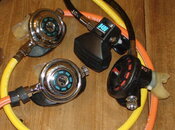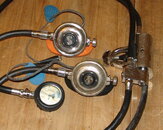All,
These aren't really "vintage," since the regs in the first pic were purchased between 1987 and ~1993. And those in the second pic were purchased ~1983. But, I thought I would offer this anyway.
I purchased the regs in the first photo (2 x Balanced Adjustable, G250, and D400) with 3 x Mk 10 firsts. They were "perfect" regs until I began using cave-filled HP tanks in very cold Great Lakes water. Then I briefly switched out the firsts for Poseidon Odin firsts (to handle the tank pressure and the cold), before replacing the seconds with Poseidon Odin seconds. (Some free-flow drama on back-to-back deep air dives in Lake Huron convinced me that 1st and 2nd stages which are designed as a system "should" be dived together as a system during more demanding dives.)
Anyway, the SP's served perfectly after that as deco bottle regs, with one of the Balanced Adjustables—the one with the clearest etching on its bezel—being used exclusively for overboard oxygen. And even now I use/prefer the SP's when I'm not diving cave-filled HP tanks in very cold water. The G250 breathes every bit as nicely as the Balanced Adjustables, and has held up every bit as well. I have zero complaints about it, and I have never regretted purchasing it. (BTW, I service the firsts and seconds myself—except for the D400, my favorite 2nd for rec dives in temperate water, which has never been serviced beyond its initial out-of-the-box service. The internals of my early-edition G250 and the Balanced Adjustables are almost identical.)
About the second photo: This reg belongs to a friend who graduated our university scuba course years before I did, years before I met him. After he had been a TA for the course for several semesters, he left for a couple of years to be a scuba instructor on Grand Cayman. I met him when he returned to complete his university degree and continue on to graduate school. He was my TA. He took this req with him when he instructed in GC, where it saw extremely heavy use, and perhaps not the best of care, though carefully rinsed under pressure at the end of each day of work, he said. (Note the pitting/dents on the chrome and the missing chrome.) About a dozen years ago, he asked me to service/rebuild his reg. It hadn't been used then for about 10 years. When I took apart the reg, I was amazed at the condition of its internal parts: almost pristine! After reassembling it, I test dove it, and it performed every bit as well as my own regs! This vintage of SP regs is remarkable! I hope Scubapro is still manufacturing to this degree of outstanding quality!
Oh, why do I still have his reg? Well, he didn't go diving after all after I serviced his reg, so he asked me to just hang on to it. That was about a dozen years ago. When we chat from time to time, I remind him I still have it. "Just hang on to it, please."
Safe Diving,
Ronald
EDIT: Just spoke with my friend, the owner of the reg in the second photo. He said he took this reg with him to GC in 1978. So I guess it's "vintage" gear after all!










